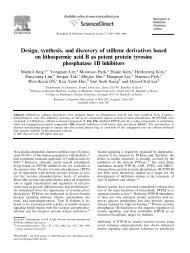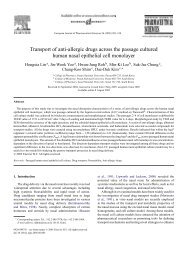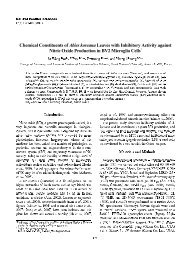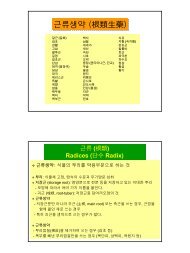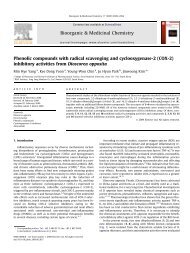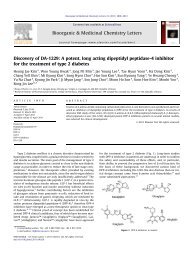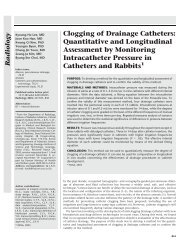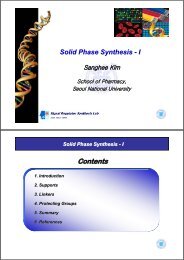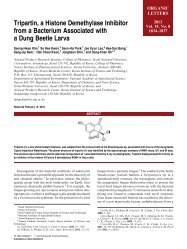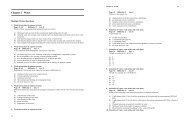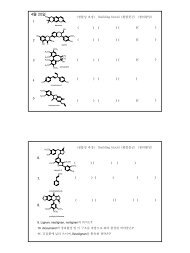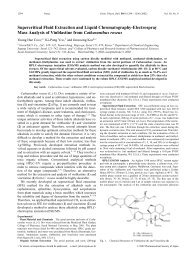Enantioselective Synthesis of (-)-cis-Clavicipitic Acid
Enantioselective Synthesis of (-)-cis-Clavicipitic Acid
Enantioselective Synthesis of (-)-cis-Clavicipitic Acid
Create successful ePaper yourself
Turn your PDF publications into a flip-book with our unique Google optimized e-Paper software.
<strong>Enantioselective</strong> <strong>Synthesis</strong> <strong>of</strong> (-)-<strong>cis</strong>-<strong>Clavicipitic</strong><strong>Acid</strong>Jin-Mo Ku, † Byeong-Seon Jeong, ‡ Sang-sup Jew,* ,† andHyeung-geun Park* ,†Research Institute <strong>of</strong> Pharmaceutical Science and College <strong>of</strong>Pharmacy, Seoul National UniVersity, Seoul 151-742, Korea,and College <strong>of</strong> Pharmacy, Yeungnam UniVersity,Gyeongsan 712-749, Koreahgpk@snu.ac.kractivity <strong>of</strong> 1, we need to develop an efficient synthetic method.So far there have been several enantioselective syntheticmethods, but the chemical yield or enantioselectivities were notsuitable for large-scale preparation and the stereocontrolledsynthesis <strong>of</strong> the C(10)-position was not reported. 3,4 In this note,we report a new efficient enantioselective synthesis <strong>of</strong> (-)-<strong>cis</strong>clavicipiticacid via asymmetric phase-transfer catalytic alkylationfor C(5S) chirality and diastereoselective Pd(II)-catalyzedintramolecular aminocyclization for C(10S) chirality.SCHEME 1ReceiVed June 1, 2007An enantioselective synthetic method for (-)-<strong>cis</strong>-clavicipiticacid (1) was reported. 1 was obtained in 10 steps (99% eeand 20% overall yield) from 1H-indole-3-carboxylic acidmethyl ester (9) via asymmetric phase-transfer catalyticalkylation and diastereoselective Pd(II)-catalyzed intramolecularaminocyclization as key steps.<strong>Clavicipitic</strong> acid (1), an ergot alkaloid isolated from SD58and ClaViceps fusiformis, has a unique tricyclic azepinoindoleskeleton. 1 There are two chiral centers (C(5) and C(10)) in 1but a mixture <strong>of</strong> diastereomers bearing C(5S) was naturallyobtained. 1 is regarded as a derailed product at high pHenvironmental condition in the clavine alkaloid biosyntheticpathway. 2Recently, we developed the asymmetric phase-transfer alkylation<strong>of</strong> the N-(diphenylmethylene)glycine tert-butyl ester (4)in the presence <strong>of</strong> cinchona alkaloid-derived quaternary ammoniumsalts, and successfully applied them to the enantioselectivesynthesis <strong>of</strong> natural and non-natural R-amino acids. 5 Asshown in the retrosynthetic analysis (Scheme 1), the enantioselectivephase-transfer catalytic alkylation was employed as thekey step for the introduction <strong>of</strong> the 5S chirality in 1 and theconstruction <strong>of</strong> the azepinoindole ring system was planned bya Pd(0)-catalyzed Heck reaction, 4a followed by diastereoselectiveBecause <strong>of</strong> the low amount <strong>of</strong> production <strong>of</strong> 1, a systematicevaluation <strong>of</strong> its biological activities has not been extensivelyperformed. As a part <strong>of</strong> our program to study the biological* Address correspondence to this author. Phone: 82-2-880-8264. Fax: 82-2-872-9129.†Seoul National University.‡Yeungnam University.(1) (a) Robbers, J. E.; Floss, H. G. Tetrahedron Lett. 1969, 1857. (b)King, G. S.; Mantle, P. G.; Szczyrbak, C. A.; Waight, E. S. J. Chem. Soc.1977, 2099.(2) (a) Saini, M. S.; Cheng, M.; Anderson, J. A. Phytochemistry 1976,15, 1497. (b) Bajwa, R. S.; Kohler, R.-D.; Saini, M. S.; Cheng, M.;Anderson, J. A. Phytochemistry 1975, 14, 735.10.1021/jo071162h CCC: $37.00 © 2007 American Chemical SocietyPublished on Web 09/18/2007(3) (a) Kozikowski, A. P.; Greco, M. N. J. Org. Chem. 1984, 49, 2310.(b) Kozikowski, A. P.; Greco, M. N. Tetrahedron Lett. 1982, 23, 2005. (c)Kozikowski, A. P.; Okita, M. Tetrahedron Lett. 1985, 26, 4043. (d) Robbers,J. E.; Otsuka, H.; Floss, H. G.; Arnold, E. V.; Clardy, J. J. Org. Chem.1980, 45, 1117. (e) Boyles, D. A.; Nichols, D. E. J. Org. Chem. 1988, 53,5128. (f) Harrington, P. J.; Hegedus, L. S.; McDaniel, K. F. J. Am. Chem.Soc. 1987, 109, 4335.(4) (a) Yokoyama, Y.; Matsumoto, T.; Murakami, Y. J. Org. Chem. 1995,60, 1486. (b) Iwao, M.; Ishibashi, F. Tetrahedron 1997, 53, 51. (c)Yokoyama, Y.; Hikawa, H.; Mitsuhashi, M.; Uyama, A.; Murakami, Y.Tetrahedron Lett. 1999, 40, 7803. (d) Shinohara, H.; Kukuda, T.; Iwao, M.Tetrahedron 1999, 55, 10989. (e) Yokoyama, Y.; Hikawa, H.; Mitsuhashi,M.; Uyama, A.; Hiroki, Y.; Murakami, Y. Eur. J. Org. Chem. 2004, 1244.(5) (a) Lee, J.-H.; Jeong, B.-S.; Ku, J.-M.; Jew, S.-s.; Park, H.-g. J. Org.Chem. 2006, 71, 6690. (b) Kim, S.; Lee, J.; Lee, T.; Park, H.-g.; Kim, D.Org. Lett. 2003, 5, 2703. (c) Jew, S.-s.; Jeong, B.-S.; Yoo, M.-S.; Huh, H.;Park, H.-g. Chem. Commun. 2001, 1244. (d) Park, H.-g.; Jeong, B.-S.; Yoo,M.-S.; Lee, J.-H.; Park, M.-K.; Lee, Y.-J.; Kim, M.-J.; Jew, S.-s. Angew.Chem., Int. Ed. 2002, 41, 3036. (e) Jew, S-s.; Jeong, B.-S.; Lee, J.-H.; Yoo,M.-S.; Lee, Y.-J.; Park, B.-S.; Kim, M.-G.; Park, H.-g. J. Org. Chem. 2003,68, 4514. (f) Park, H.-g.; Kim, M.-J.; Park, M.-K.; Jung, H.-J.; Lee, J.;Choi, S.-h.; Lee, Y.-J.; Jeong, B.-S.; Lee, J.-H.; Yoo, M.-S.; Ku, J.-M.;Jew, S.-s. J. Org. Chem. 2005, 70, 1904.J. Org. Chem. 2007, 72, 8115-8118 8115
FIGURE 1. Chiral phase-transfer catalyst.SCHEME 2intramolecular aminocyclization induced by C(5S) chirality forthe introduction <strong>of</strong> the C(10S) chirality. 4bFirst, the alkylating agent 13 for the asymmetric phase-transfercatalytic alkylation was prepared in 4 steps from 1H-indole-3-carboxylic acid methyl ester (9). The addition <strong>of</strong> thallium(III)trifluoroacetate in a TFA solution <strong>of</strong> 9, followed by the treatment<strong>of</strong> potassium iodide afforded 10 (74%). The N-Boc protection<strong>of</strong> indole 10 with (Boc) 2 O in the presence <strong>of</strong> DMAP gave 11(98%). The reduction <strong>of</strong> methyl ester <strong>of</strong> 11 with DIBAL-H,followed by benzylic bromination with PBr 3 provided thealkylating agent 13 (62%).The phase-transfer catalytic alkylation was performed from4 with 4-iodo-N-Boc-3-bromomethylindole (13) under phasetransfercatalytic reaction conditions <strong>of</strong> 50% aqueous KOH intoluene-chlor<strong>of</strong>orm (volume ratio ) 7:3) at 0 °C (Scheme 2).We employed three representative catalysts (PTCs, 6-8, Figure1) which showed excellent catalytic efficiencies in the enantioselectivecatalytic alkylation 4. 5d,6As shown in Table 1, very high enantioselectivities wereobserved in the case <strong>of</strong> both 6 5d (99% ee) and 7 6a (99% ee), but(6) (a) Park, H.-g.; Jeong, B.-S.; Yoo, M.-S.; Lee, J.-H.; Park, B.-s.; Kim,M. G.; Jew, S.-s. Tetrahedron Lett. 2003, 44, 3497. (b) Ooi, T.; Kameda,M.; Maruoka, K. J. Am. Chem. Soc. 1999, 121, 6519. (c) Corey, E. J.; Xu,F.; Noe, M. C. J. Am. Chem. Soc. 1997, 119, 12414.TABLE 1. The <strong>Enantioselective</strong> Phase-Transfer CatalyticAlkylation ano. catalyst time, h yield, b % ee, c % (config) d1 6 12 97 99 (S)2 7 12 85 99 (S)3 8 12 69 65 (S)a The reaction was carried out with 1.0 equiv <strong>of</strong> alkylating agent and3.0 equiv <strong>of</strong> 50% KOH in the presence <strong>of</strong> catalyst (10 mol %) in toluene/CHCl 3 (7:3). b Isolated yields. c Enantiopurity was determined by HPLCanalysis <strong>of</strong> 14, using a chiral column (Chiralcel OD) with hexane/2-propanolas an eluent; in this case it was established by analysis <strong>of</strong> the racemate, <strong>of</strong>which the enantioisomers were fully resolved. d Absolute configuration wasdetermined by comparison <strong>of</strong> the optical rotation <strong>of</strong> (-)-<strong>cis</strong>-clavicipitic acid(1) transformed from 14 with the reported value. 4b6 (97%) showed higher chemical yield compared to that <strong>of</strong> 7(85%). The non-cinchona catalyst, 8, 6b afforded relatively poorresults in both chemical yield and enantioselectivity. Theenantiopurities were determined by chiral HPLC analysis with8116 J. Org. Chem., Vol. 72, No. 21, 2007
TABLE 2.The <strong>Synthesis</strong> <strong>of</strong> 15 with Use <strong>of</strong> the Heck Reaction aNo. catalyst additives base solvent temp, °C time, h yield, b %1 Pd(Ph 3P) 2Cl 2 Ag 2CO 3 (1.0 equiv) Et 3N (10 equiv) DMF 100 3 212 Pd(Ph 3P) 2Cl 2 Ag 2CO 3 (1.0 equiv) Et 3N (10 equiv) toluene 110 3 N.R.3 Pd(Ph 3P) 2Cl 2 Ag 2CO 3 (1.0 equiv) K 2CO 3 (2 equiv) DMF 100 6 534 Pd(Ph 3P) 2Cl 2 Ag 2CO 3 (1.0 equiv) K 2CO 3 (2 equiv) DMF/H 2O 90 3 525 Pd(Ph 3P) 2Cl 2 K 2CO 3 (2 equiv) DMF/H 2O 90 3 546 Pd(Ph 3P) 4 K 2CO 3 (2 equiv) DMF/H 2O 90 2 N.R7 Pd(DIPHOS) 2 K 2CO 3 (2 equiv) DMF/H 2O 90 3 658 [Pd(η 3 -C 3H 5)Cl] 2 K 2CO 3 (2 equiv) DMF/H 2O 90 3 429 Pd(OAc) 2 K 2CO 3 (2 equiv) DMF/H 2O 90 2 90a The above reaction was allowed to stir with 45 equiv <strong>of</strong> 2-methylbut-3-en-2-ol and base in the presence <strong>of</strong> catalyst (0.1 equiv) in solvent until darkmaterial was precipitated. b Isolated yields.use <strong>of</strong> Chiralcel OD. The absolute configuration <strong>of</strong> 14 wasdetermined as S by comparison <strong>of</strong> the optical rotation <strong>of</strong> thefinal product, (-)-<strong>cis</strong>-<strong>Clavicipitic</strong> acid {1, [R] 25 D -238 (c 0.2,EtOH)} transformed from 14 with the reported values {1,[R] 25 D-249 (EtOH) 4b }.We next investigated the Pd(0)-catalyzed Heck reaction <strong>of</strong>14 to afford 15. At the beginning, we adapted the previous Heckreaction condition for the synthesis <strong>of</strong> clavicipitic acid reportedby Yokoyama et al. in 1995. 4a The Heck reaction <strong>of</strong> 14 withPd(Ph 3 P) 2 Cl 2 in the presence <strong>of</strong> Ag 2 CO 3 under DMF solvent at100 °C gave 15 in only 21% chemical yield (Table 2, entry 1).The Heck reaction conditions needed to be optimized by thevariation <strong>of</strong> solvent, catalyst, and base. Toluene solvent showedno reaction but quite increased chemical yield could be observedby replacing Et 3 N with K 2 CO 3 (entry 3, 53%). The aqueousDMF solvent system, DMF-H 2 O (volume ratio ) 1:1), showedcomparable chemical yield but two times faster reaction ratethan the DMF only solvent system (entries 3 and 4). Interestingly,the removal <strong>of</strong> Ag 2 CO 3 did not show any significantchange in chemical yield (entries 4 and 5). We then moved ourattention to optimize Pd(0) catalyst. An additional four kinds<strong>of</strong> Pd(0) catalysts were chosen and their catalytic efficiency wasevaluated (entries 6-9). Among the used catalysts, Pd(OAc) 2gave the highest chemical yield in the presence <strong>of</strong> K 2 CO 3 underthe 50% aqueous DMF solvent system to give 15 (entry 9, 90%).Next, the benzophenone imine moiety <strong>of</strong> 15 was selectivelyhydrolyzed with 0.1 M citric acid to afford 16 (96%). The directazepinoindole ring construction from 16 was attempted by acidiccondition with PPTS in CH 2 Cl 2 , but only a diastereomericmixture (1:1.2) <strong>of</strong> the corresponding trans-(5S,10R)-N(1)-Bocclavicipiticacid tert-butyl ester and <strong>cis</strong>-(5S,10S)-N(1)-Bocclavicipiticacid tert-butyl ester was obtained, respectively (datanot shown). We speculate that the poor diastereoselectivity <strong>of</strong>the C(10)-position induced by C(5S) chirality might be due tothe less steric hindered environment. So we finally employedPd(II)-catalyzed intramolecular aminocyclization. 7 The N-Bocprotection <strong>of</strong> 16 was performed with (Boc) 2 O in the presence<strong>of</strong> DMAP to give 17 (93%). The intramolecular aminocyclization<strong>of</strong> 17 was performed with PdCl 2 (CH 3 CN) 2 in CH 3 CNFIGURE 2. Plausible transition state in the Pd(II)-catalyzed aminocyclization.solvent at 90 °C for 24 h, which could afford <strong>cis</strong>-18 and trans-18 at the ratio <strong>of</strong> 5 to 1, respectively. 8On the basis <strong>of</strong> the diastereoselectivity, the plausible transitionstate in the aminocyclization is proposed in Figure 2. The Pd-(II) catalyst forms a complex with the allylic alcohol group in17 from the upside, followed by the approach <strong>of</strong> C(5S)-BocNHfrom the downside to afford <strong>cis</strong>-18. In the case <strong>of</strong> trans-18, thePd(II) catalyst should form a complex with the allylic alcoholgroup from the downside and C(5S)-BocNH approach from theupside to the allylic alcohol group, but there might be severesteric hindrance between C(5S)-CO 2 t Bu and the Pd(II)-allylicalcohol complex, which might give the trans-isomer as a minorproduct. The nonseparable diastereomeric mixture <strong>of</strong> 18 wasdirectly adapted to hydrolysis without further separation. SinceShinohara et al. reported that a partial epimerization <strong>of</strong> theC(10)-position occurred during the thermolytic deprotectioncatalyzed by silica gel (SiO 2 ), 9 we need to find a milder reactioncondition at low temperature. After several trials with varioushydrolysis methods, we finally overcame the epimerization byusing ZnBr 2 . 10 18 could be selectively converted to the (-)-(7) (a) Hirai, Y.; Terada, T.; Amemiya, Y.; Momose, T. TetrahedronLett. 1992, 33, 7893. (b) Makabe, H.; Kong, L.-K.; Hirota, M. Org. Lett.2003, 5, 27. (c) Yokoyma, H.; Otaya, K.; Kobayashi, H.; Hirai, Y. Org.Lett. 2000, 2, 2427.(8) Since <strong>cis</strong>-18 and trans-18 were not separable, their ratio wasconfirmed by the ratio <strong>of</strong> <strong>cis</strong>-1 and trans-1 derived from the hydrolysis <strong>of</strong>the diastereomeric mixture <strong>of</strong> 18.(9) Otey, C.; Greentein, J. P. J. Am. Chem. Soc. 1955, 77, 3112.(10) Kaul, R.; Brouillette, Y.; Sajjadi, Z.; Hansford, K. A.; Lubell, W.D. J. Org. Chem. 2004, 69, 6131.J. Org. Chem, Vol. 72, No. 21, 2007 8117
<strong>cis</strong>-clavicipitic acid (90%) by the treatment <strong>of</strong> ZnBr 2 in CH 2 -Cl 2 without any epimerization. 11In conclusion, (-)-<strong>cis</strong>-clavicipitic acid has been synthesizedin 10 steps (20% overall yield, 99% ee) with asymmetric phasetransfercatalytic alkylation and diastereoselective Pd(2)-catalyzed intramolecular aminocyclization as key steps from 1H-Indole-3-carboxylic acid methyl ester (9). We believe theefficient synthetic method would facilitate the studies on thebiological evaluation <strong>of</strong> (-)-<strong>cis</strong>-clavicipitic acid.Experimental SectionRepresentative Procedure for the <strong>Enantioselective</strong> Phase-Transfer Catalytic Alkylation <strong>of</strong> 4 (14). To a mixture <strong>of</strong> 13 (29mg, 0.067 mmol) and chiral catalyst 6 (6.6 mg, 0.0067 mmol) insolvent (dichloromethane:toluene ) 3:7) (0.67 mL) was addedN-(diphenylmethylene)glycine tert-butyl ester (4) (19.6 mg, 0.067mmol). The reaction mixture was then cooled (0 °C), aq 50% KOH(13.7 mg, 0.24 mmol) was added, and the reaction mixture wasstirred at 0 °C until starting material was consumed (8 h). The(11) No epimerization was confirmed by the hydrolysis <strong>of</strong> the <strong>cis</strong>-(5S,-10S)-N(1)-Boc-clavicipitic acid tert-butyl ester and trans-(5S,10R)-N(1)-Boc-clavicipitic acid tert-butyl ester derived from 16 by the acidiccyclization with PPTS in CH 2Cl 2. The separable <strong>cis</strong>- and trans-isomer couldbe hydrolyzed to afford <strong>cis</strong>-1 and trans-1 without any epimerization byZnBr 2 in CH 2Cl 2, respectively. The related scheme and procedure areprovided in the Supporting Information.suspension was diluted with diethyl ether (20 mL), washed withwater (2 × 5 mL), dried over Na 2 SO 4 , filtered, and concentratedin vacuo. Purification <strong>of</strong> residue by column chromatography onsilica gel (hexanes:EtOAc ) 10:1) afforded the desired product 14(42 mg, 97% yield) as a pale yellow oil. The enantioselectivitywas determined by chiral HPLC analysis (Chiralcel OD, hexanes:2-propanol ) 500:2.5, flow rate ) 1.0 mL/min, 23 °C, λ ) 254nm, retention times: R (minor) 19 min, S (major) 23.3 min, 98.8%ee).Representative Procedure for the Pd(II)-Catalyzed IntramolecularAminocyclization (18). To an acetonitrile solution <strong>of</strong> 17(90 mg, 0.16 mmol) was added PdCl 2 (CH 3 CN) 2 (4 mg, 0.016 mmol)at room temperature. The reaction solution was allowed to stir atroom temperature until the starting material was consumed. Aftercooling, the reaction mixture was quenched with water, diluted withethyl acetate, washed with water, dried over Na 2 SO 4 , filtered, andconcentrated in vacuo. The residue was purified by columnchromatography on silica gel (hexanes:EtOAc ) 6:1) to affordinseparable mixture <strong>of</strong> diastereomer, <strong>cis</strong>-18 and trans-18 (5:1) (66mg, 76% yield).Acknowledgment. This work was supported by a grant(E00257) from the Korea Research Foundation (2006).Supporting Information Available: Spectroscopic characterizations<strong>of</strong> 1and 10-17. This material is available free <strong>of</strong> chargevia the Internet at http://pubs.acs.org.JO071162H8118 J. Org. Chem., Vol. 72, No. 21, 2007



